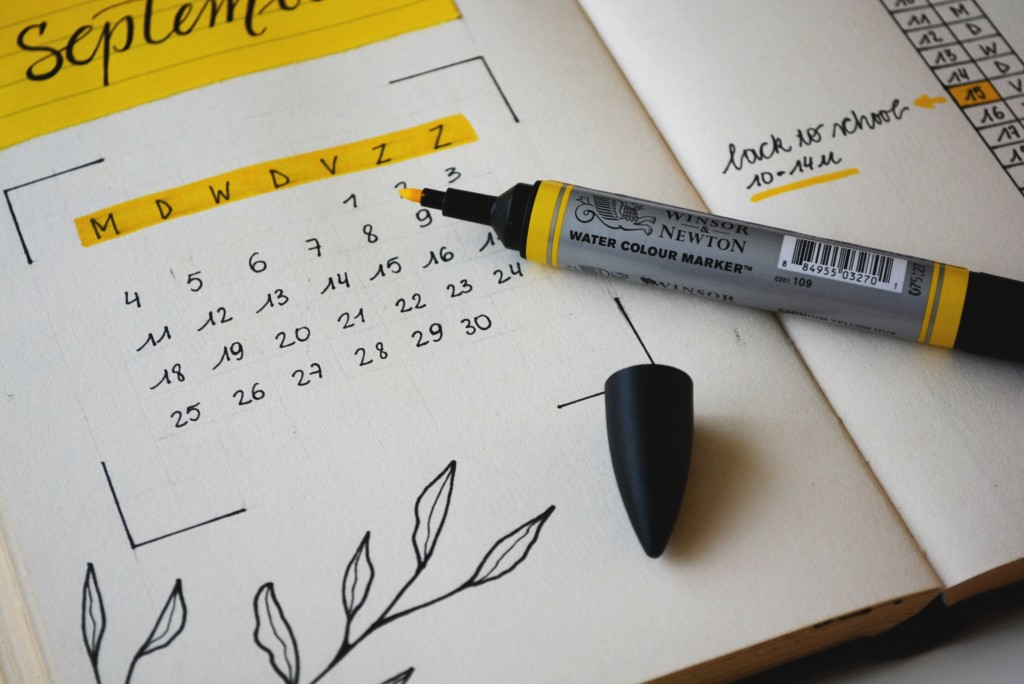
Most students going into year 12 have some idea of what goals they want to achieve by the end of the year. Usually these are along the lines of ‘improving in maths’ or ‘getting a good ATAR’, but setting vague goals like these doesn’t always work out!
In order to really set a goal and then achieve it, you have to figure out exactly what you want and how you plan to get it. From there it’s just a case of working to achieve smaller, short-term goals that will build towards your overall goal.
But how exactly do you go about all this goal setting? You follow this guide of course! By the end of this article we’ll have developed a full ‘Goal Achievement Sheet’ together, making you a pro at setting and achieving goals.
But first, download this template to fill in through this article!
Step 1: Choose a Long-Term Goal
Step 2: Identify How You Will Achieve Your Long-Term Goal
Step 3: Create Short-Term Goals
Step 4: Set Dates for Your Goals
Step 1: Choose a Long-Term Goal
Before we start, let’s point out just why goal setting is a good idea. A study at Harvard says that, “Specifically, when students set their own goals, they take responsibility and ownership of their learning goals.”.
Now, that may just sound like some fancy academic speak, but what it’s really saying is that if you set your own goals you’re way more likely to achieve them. Setting goals pretty easy, but it’s not as simple as deciding ‘I want a good English mark’ and being done with it!
Long-term goals are ones that have to be achieved over time, so tidying your room or handing in that assignment won’t feature here. In order to set an achievable long-term goal it needs to be specific so that you know exactly what you’re working towards, especially because you are working over a longer period of time. You can turn vague goals into achievable ones pretty easily just by changing how you word it!
Here are some popular vague goals I hear from students:
- Get a good ATAR
- Get into a good uni for the course I want
- Improve in (subject)
- Do well in trials
- Get into better study habits
By figuring out exactly what you want, or a benchmark that you want to achieve, these can easily be made into more specific goals.
- Get an ATAR over 84
- Get into UNSW or UTS for a bachelor of Journalism
- Get 85% on my next English assessment
- Average a mark of 75% in trials
- Start studying 4 hours a week
Even though these goals are still aiming for the same thing, being specific makes it much easier to figure out where you are now (point A) and where you want to be (point B). For example, the third goal was improving in a subject. If your last English mark was 73 this is your point A, but if your goal is just to “improve you haven’t really set a clear point B. However, by saying you want to achieve 85% or more you’re letting yourself know exactly what you’re working towards, meaning you know your point B.
By listing your goals this way you can quickly pick out which ones you can start working towards now and which ones are more of a sustained effort. For example, you could start working on goals 3 and 4 right away, but goals 1,2 and 5 could probably only be planned out at the moment.
Try it: using the template you downloaded here list 3-5 long-term goals and try to make them specific like in the second list of examples above. Then pick out one that you’d like to start planning!
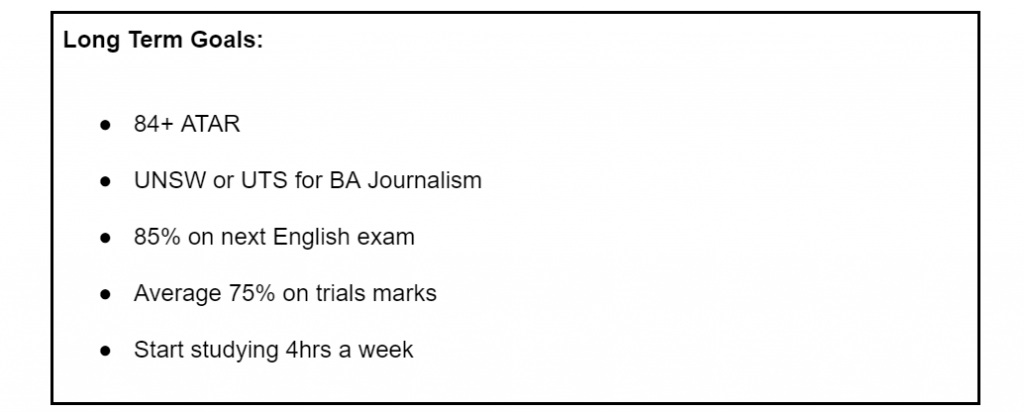
Step 2: Identify How You Will Achieve Your Long-Term Goal
In order to start working towards a long-term goal we need to know exactly what it’s going to take to achieve it. This usually means doing some research and crunching some numbers, but don’t freak out just yet! Most of this is just to set benchmarks and prepare for what’s to come.
Figuring out the ‘criteria’ for achieving long-term goals varies from goal to goal. In some cases, such as improving in a certain subject, most of your criteria will be pretty obvious.
You’ll want to look at increasing study time, improving marks on practice papers and creating better study notes – all fairly common sense.
For bigger goals, however, it’s a little trickier to figure out just what you need to do and how much detail you should be going into, so let’s pull it apart in an example.
Is your goal to improve in HSC Chemistry this year? Check out our Top 5 Study Tips for Chemistry to see results!
Example
Let’s say you’re hoping to get into the University of New South Wales to study Journalism, your goal ATAR will obviously be defined by their course requirements. This means that you’ll have to do a little bit of work to figure out your goal criteria.
The first thing you need to know is what ATAR you need, so hop over to the UNSW website and check out their course requirements.

Now that you know your goal ATAR, you want to figure out where you’re currently sitting.
This is a good time to make use of ATAR calculators, which you can plug your most recent exam results into to see how you’re faring.
It will give you an approximate ATAR that you can use as a benchmark to improve from.
You can check out our full article on using ATAR calculators here!
Then you’ll want to check what marks would actually get you to your goal ATAR, which you can do in the same ATAR calculator. Just reverse the process and you’ll get ‘goal’ marks for all of your subjects! Round these up to a whole number for an easier mark to remember and you’re good to go.
By comparing your current marks and your goal marks you can quickly see how much you need to improve in order to achieve your ATAR goal. At this point you may want to start considering how much study you think you’ll need to be doing, what habits you should get into, etc. These also count as criteria for achieving your ATAR goal.
In this example we essentially broke our criteria down into 3 major areas.
Goal ATAR
- UNSW requirement: 84
- Goal: 84
- Current estimate: 71.95
HSC Subject Mark Goals
- Advanced English: 84
- Extension 1 English: 41
- Extension 2 English: 39
- Biology: 82
- General Maths: 86
- Visual Arts: 88
- Modern History: 84
Study Goals
- Study more often
- Improve study notes
- Get into better study habits
It seems like a lot to think about, but in fact what we’ve done is broken our long-term goal down into a whole bunch of smaller, more-achievable short-term goals. This means that not only are you planning exactly how you’re going to achieve your goal, you’re also beginning on the next step of the process: creating short term goals!
Try it: using the goal you chose in step 1, list down at least 5 criteria that you need to achieve it. Think about how much you may need to study, any subjects you may need to improve in and even simple things like completing assignments.
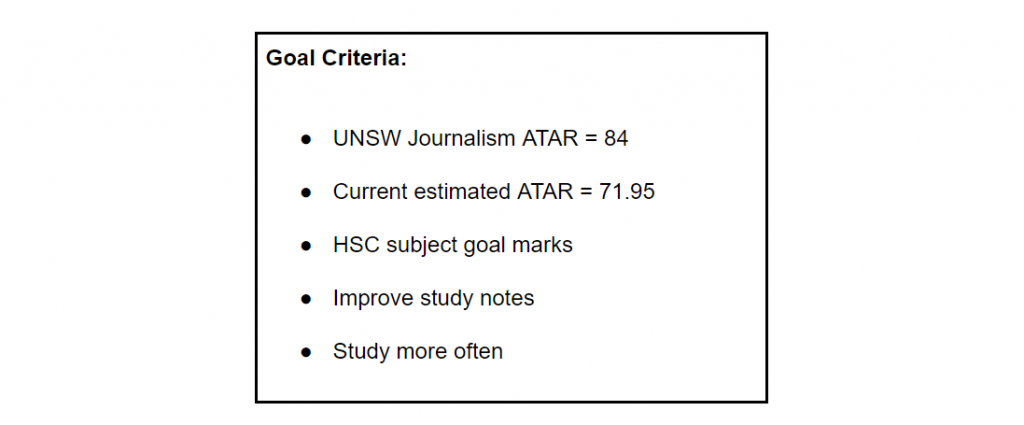
Step 3: Create Short-Term Goals That Work Towards Your Long-Term Goal
This is super quick and simple because it’s basically rewording what you did in the last step!
All you need to do is take your criteria and turn it into a short-term goal. For example “improve weekly study” may turn into “Study 3 hours every weekend” or “Average 6 hours of study a week” depending on your long-term goal.
In some cases, especially for the larger goals, you may need to break things down further. Some criteria can’t be achieved right away, therefore you turn it into progressive short term goals that you regularly change or repeat in order to achieve a certain criteria. Let’s look at one from our example.
Example
Criteria involving trials or HSC marks often needs to be worked towards over time. In our ATAR goal example one criteria was to achieve an Advanced English mark of 85 in the HSC, however you can’t do that at the beginning of the year. Instead we’ll work with benchmarks that you gradually improve.
Say your English mark in the first assessment of year 12 is 67. If you want to improve to 85 by the HSC, you’ll have to take things in steps over the next 3 terms.
84 – 67 = 17
17 ÷ 3 = 5.6
This means that by the end of each term you want to have improved by at least 5.6 marks, or 6 marks if we were to round it. That seems way more manageable than 17 marks all up! Of course, you may improve at a faster or slower rate, so make sure to come back and re-evaluate this goal each term to make sure you’re still on track!
You can also add goals to work towards this mark increase, such as “Study 2 hours of English each weekend” or something similar, just to keep things organised and moving.
Try it: using the list you made in step 2 from our goal planner here turn your criteria into short term goals! Try to pick out at least one that you can expand into more detailed goals or ones with multiple steps (e.g. improve marks by x% and study x hours a week).
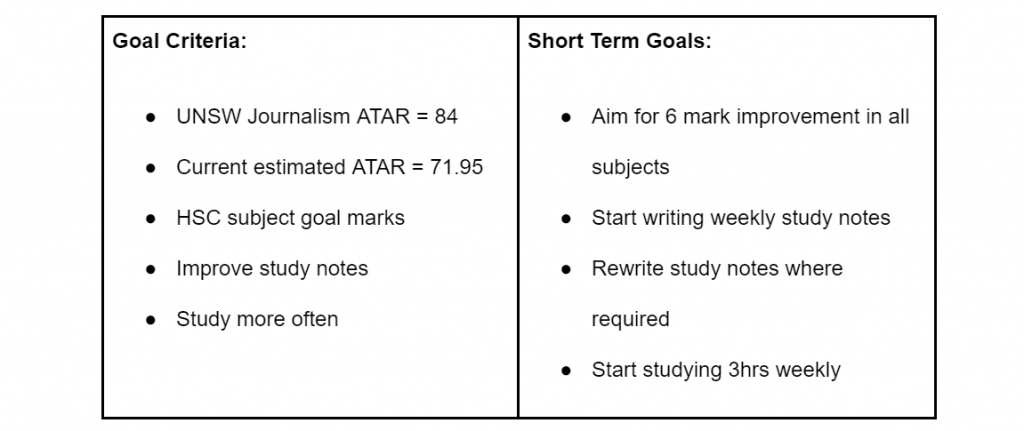
Step 4: Set Dates for Your Goals
How far you want to take this step is entirely up to you, but it’s important that you at least figure out something of a schedule for your goals. At minimum this means knowing when you plan to complete or achieve each of your short-term goals by!
Do this by simply grabbing a calendar and mapping out when your key dates are for exams, assignments, trials and HSC.
From there figure out when you want to achieve your long term goal by (some, such as HSC marks or ATAR goals can’t really be chosen) and how much time you then have to achieve short-term goals. Then just jot down when you want to complete each short-term goal by!
Make sure to then write down your ‘due dates’ for each short-term goal on your goal sheet to make sure you don’t forget when you mean to complete them. Also, don’t forget that if you’re working on multiple goals at once you’ll need to space out when your goals are due, otherwise you’ll burn out!
Try it: using a calendar and your exam/assignment schedule, plan out when you want to complete each of your short-term goals and finish filling out your goal sheet!

Conclusion
There you have it! Setting and achieving goals can seem really daunting at the start of year 12, but by planning ahead and figuring out just what you need to do, anyone can do it.
By now you’ve already filled out one full goal sheet, so you’re ready to get started on one long-term goal, but you don’t have to stop there.
You can use the same sheet template for any of your long-term goals, meaning you can just keep achieving. In fact, why not make one now?
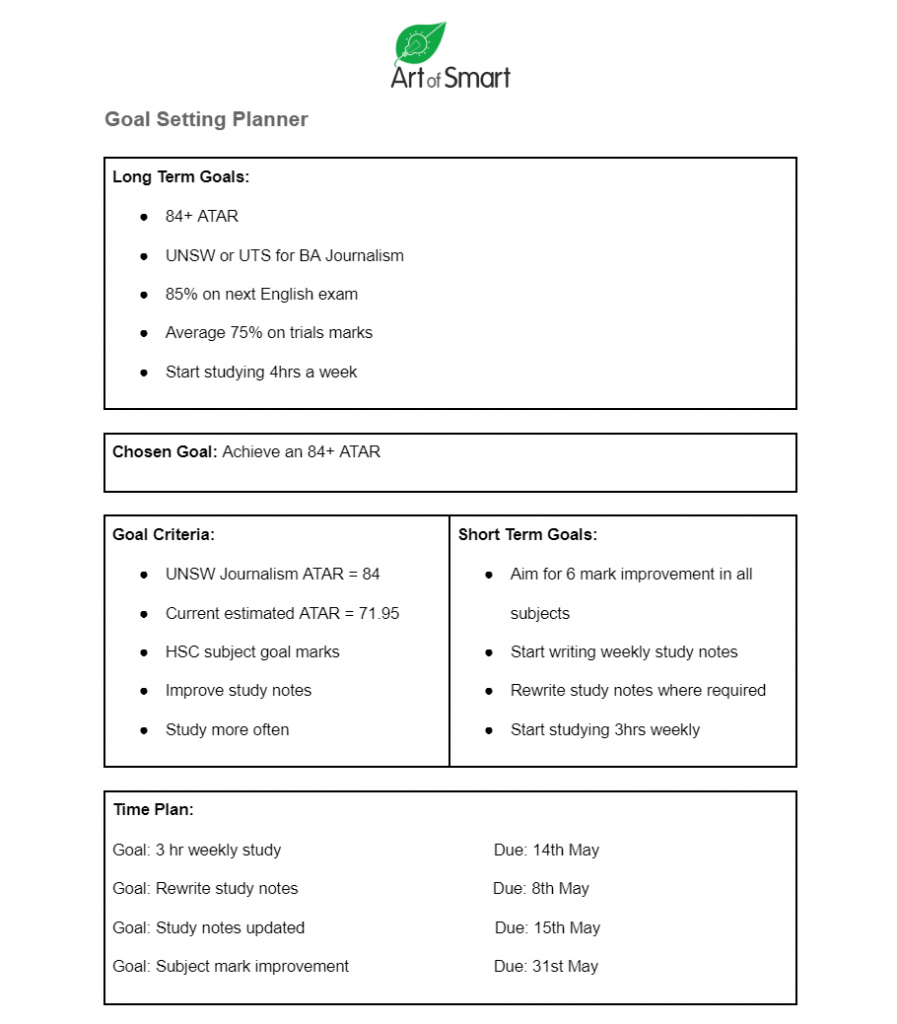
Here’s the template again, so fill it out for another one of your long-term goals and achieve away!
Good luck with your goals!
Looking for some extra help with the HSC?
We have an incredible team of HSC tutors and mentors who are new HSC syllabus experts!
We can help you master the HSC syllabus and ace your upcoming HSC assessments with personalised lessons conducted one-on-one in your home or at our state of the art campus in Hornsby!
We’ve supported over 5,000 students over the last 10 years, and on average our students score mark improvements of over 19%!
To find out more and get started with an inspirational HSC tutor and mentor, get in touch today or give us a ring on 1300 267 888!
Maddison Leach completed her HSC in 2014, achieving an ATAR of 98.00 and Band 6 in all her subjects. She enjoys helping students through the academic and other aspects of school life, even though it sometimes makes her feel old. Maddison has had a passion for writing since her early teens, having had several short stories published before joining the world of blogging. She’s currently studying a Bachelor of Design at the University of Technology Sydney and spends most of her time trying not to get caught sketching people on trains.


